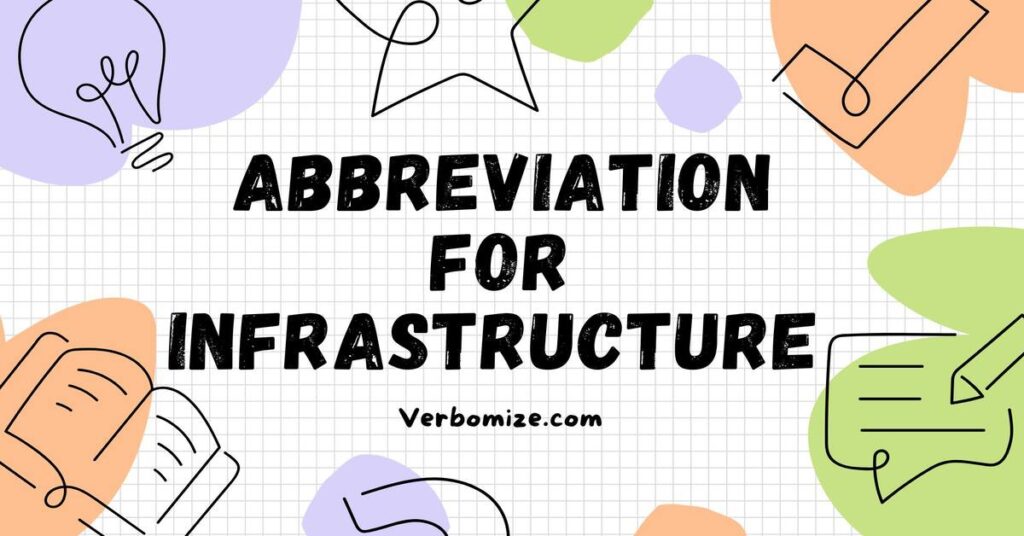The abbreviation for Infrastructure is something you’ve probably seen before, but might not fully understand. It’s more than just a quick way to say something—it holds significant meaning in various industries, from construction to tech. Knowing what it stands for can help you navigate conversations and documents with ease, especially in professional settings.
So, if you’ve ever wondered why “infra” keeps popping up or if you’re curious about its real impact, you’re in the right place. Let’s dive into the world of abbreviations and explore why infrastructure matters, and how it shapes everything around us. Keep reading!
What is the Abbreviation for Infrastructure?
The short for infrastructure is “infra.” This infrastructure abbreviation is widely used across various industries, particularly in construction, technology, and urban planning, to save time and simplify communication. “‘Infra.’ serves as a handy abbreviation for infrastructure in professional writing and conversations.” It allows experts to refer to large, complex systems and structures more efficiently, without constantly repeating the full term.
Using infra instead of writing out the entire word for infrastructure helps make conversations and documents clearer and more concise, especially in technical fields where space and time are often limited.
What Does the Abbreviation for Infrastructure Mean?
The term infra is essentially a short form of infrastructure, representing the same core idea of the term: the foundational systems and structures that support society. These systems can be physical, like roads and bridges, or digital, such as data centers and internet networks.
The abbreviation of infrastructure is primarily used to save time and space while maintaining the clarity of the concept. For example, instead of saying “the infrastructure of our city’s transportation system,” you might say “the infra. of the city’s transportation.”
Examples of Infrastructure in Context
- “Our infra. includes major highway systems and public transportation.”
- “The infra in our company needs to be upgraded to improve efficiency.”
In both cases, the abbreviation infra refers to the entire network of foundational systems that make things work.
A Quick Refresher: What is Infrastructure?
At its core, infrastructure refers to the fundamental systems that support the functionality of a society or organization. It’s essential for everything from economic activities to personal well-being. Infrastructure is typically divided into several categories:
- Physical Infrastructure: Roads, bridges, airports, railways.
- Utility Infrastructure: Water supply systems, power grids, sewage treatment.
- Communication Infrastructure: Internet networks, telecommunication systems.
- Digital Infrastructure: Servers, data centers, cloud services.
Each of these forms of infrastructure plays a critical role in maintaining society’s operations, and they’re all included when people use the infrastructure short form.
How to Pronounce Infra
The infra abbreviation is pronounced as “in-frah”. This simple pronunciation ensures that even non-native speakers can easily integrate it into conversations without confusion. Unlike some other abbreviations, “infra” is phonetically straightforward, making it an ideal shorthand for technical discussions.
Mispronunciations are rare, but it’s worth noting that some might mistakenly skip the “h” sound, pronouncing it “in-fra.” The correct pronunciation, however, is “in-frah.”
When and Why to Use “Infra.”
The short form of infrastructure—infra—is especially useful in technical, professional, and academic settings. Using infra helps simplify complex discussions that revolve around the various types of infrastructure.
Why Use “Infra”?
- Efficiency: It’s a time-saving abbreviation, particularly in fields like urban planning, construction, and IT.
- Clarity: In written reports, the short form of infrastructure helps reduce redundancy while maintaining clarity.
- Standardization: Many professionals in infrastructure-related industries are accustomed to seeing and using infra as a quick and effective way to refer to large concepts.
For example, in urban planning discussions, professionals might say:
- “The city’s infra. needs to be updated to handle the growing population.”
In the above case, “infra.” efficiently communicates the idea of infrastructure in a context where it’s widely understood.
The Significance of “Infra.” in Different Industries
Using the infrastructure acronym is particularly significant in industries where infrastructure is central to the business. Here’s a look at how different sectors use the infra abbreviation.
IT Infrastructure
In the world of technology, IT infrastructure refers to the digital systems that power organizations. This includes everything from network systems to data centers. Professionals in IT frequently use infra to describe their infrastructure projects, such as cloud infra., network infra., and server infra.
Example:
- “We’re upgrading our infra. to support higher cloud computing demands.”
Construction and Urban Planning
In the construction industry, infra is used to refer to public works projects like roads, bridges, and utilities. Urban planners and engineers use infra to keep discussions short and focused on large-scale infrastructure projects.
Example:
- “The proposed infra. project will include new public transit systems and roads.”
How to Abbreviate Infrastructure: A Step-by-Step Guide
Abbreviating infrastructure to “infra.” is straightforward and commonly accepted in various industries. But if you’re unfamiliar with how to abbreviate infrastructure, here’s a simple guide:
- Start with “infrastructure”: This is the full term you’ll be shortening.
- Cut down to “infra”: Remove the “structure” portion, leaving “infra.”
- Add a period: In most cases, you’ll see the short form of infrastructure written as infra., indicating that it’s an abbreviation.
This simple step helps streamline your writing and ensures that your audience quickly understands that you’re referring to infrastructure, without needing the full term every time.
Examples of Infrastructure in Context
To further explore the use of infra., let’s look at how it fits into real-world examples:
In Technology
- “We need to upgrade our infra. to handle more data traffic.”
In Construction
- “The new development will rely heavily on upgraded infra..”
In Public Services
- “The government is planning to invest more in its infra. to improve energy efficiency.”
These examples show how infra. keeps conversations focused and straightforward, allowing professionals in different fields to avoid redundancy while discussing essential systems.
Synonyms for Infrastructure
While infra is the abbreviation for infrastructure, several synonyms are used to describe similar concepts in different contexts. These include:
- Framework: Often used in technology and organizational settings to describe a structural system.
- Foundation: Used in construction to describe the supporting structures of a building or system.
- Support System: A broader term that can apply to various infrastructure types, particularly in technology or business.
These synonyms help vary language but still refer to the concept of infrastructure and its importance in maintaining functional systems.
Antonyms of Infrastructure
Understanding the antonyms of infrastructure can further emphasize its importance. Common antonyms include:
- Disrepair: Infrastructure that has deteriorated due to neglect or lack of maintenance.
- Depletion: The reduction or exhaustion of infrastructure resources, often leading to inefficiencies or failures.
- Deterioration: The gradual breakdown of infrastructure, which can hinder its ability to function.
Recognizing these antonyms can highlight the consequences of failing to invest in and maintain infra., and why infrastructure is vital for societal progress.
The Evolution of the Word ‘Infrastructure’ and Its Abbreviation
The term infrastructure originated in French in the early 19th century, initially referring to the foundation or underlying framework of systems. Over time, as infrastructure expanded to encompass everything from transportation systems to digital networks, the need for a more efficient shorthand emerged.
The infra abbreviation became popular as professionals sought ways to discuss large, complex systems in a simpler form. Today, infra. is a standard term used globally, from IT to urban planning.
Final Thoughts on the Abbreviation for Infrastructure
The abbreviation of infrastructure—infra.—is more than just a time-saver. It’s an essential tool used by professionals across industries to streamline communication and simplify the discussion of complex systems. Whether you’re in construction, IT, or urban planning, infra. helps keep conversations and documents clear, concise, and focused.
Next time you’re discussing infrastructure, feel free to use infra. It’s a widely accepted and efficient way to talk about the systems that keep society running smoothly.
By understanding how to use the short form of infrastructure, you’ll communicate more effectively in your professional field, ensuring you save time while keeping the message intact.

Jone Smith is an experienced blogger and content creator behind Verbo Mize. With a passion for storytelling and insightful commentary, Jone brings a wealth of knowledge on diverse topics. His expertise in blogging, combined with a keen eye for detail, makes his work both informative and engaging, offering readers valuable perspectives on a wide range of subjects.







